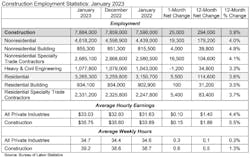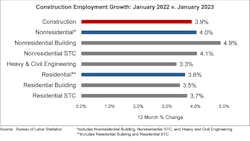Latest from Construction Data
Sponsored
WASHINGTON, DC — The construction industry added 25,000 jobs on net in January, according to an Associated Builders and Contractors analysis of data released today by the U.S. Bureau of Labor Statistics. On a year-over-year basis, industry employment has risen by 294,000 jobs, an increase of 3.9%.
Nonresidential construction employment increased by 19,300 positions on net, with growth in two of the three subcategories. Nonresidential specialty trade added 16,500 net new jobs, while nonresidential building added 4,000 positions. Heavy and civil engineering lost 1,200 jobs for the month.
The construction unemployment rate rose to 6.9% in January. Unemployment across all industries declined from 3.5% in December to 3.4% last month.
Analysis
“It is virtually impossible to reconcile today’s employment numbers with other phenomena in the U.S. economy,” said ABC Chief Economist Anirban Basu. “America’s labor market remains red hot despite falling retail sales, declining industrial production, bloated inventories and high-profile layoff announcements.
“Today’s jobs report strongly suggests that the Federal Reserve has more work to do,” said Basu. “While many will cheer the jobs report, the bond market did not, with interest rates rising immediately in response to the persistent and surprising strength of the nation’s employment market. While contractors may be thrilled to hear that the labor market remains strong, associated upticks in borrowing costs increase the likelihood of a recession sometime later this year.
“Many contractors may shrug off such concerns given current elevated backlog,” said Basu. “ABC surveys reveal that contractors plan to continue to hire and expand operations. Indeed, the nation’s nonresidential construction industry added more than 19,000 jobs in January. But the outlook may dim later this year as the cost of project financing continues to rise, setting the stage for what could be a meaningfully weaker 2024, at least in construction segments that are primarily privately financed.”
Visit abc.org/economics for the Construction Backlog Indicator and Construction Confidence Index, plus analysis of spending, employment, job openings and the Producer Price Index.




